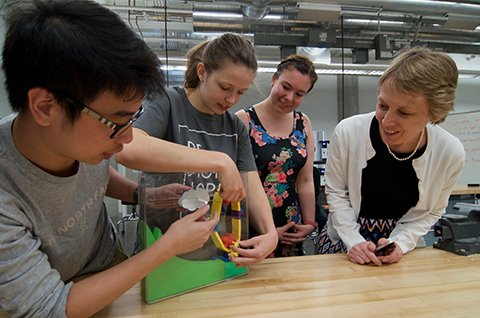New innovation lab and support from 3M allow CSE freshmen to get creative

Project-based inquiry course helps students to become better engineers
June 12, 2017
When it comes to educating the next generation of engineers, most experts agree students are most creative and innovative when they get their hands dirty, make things, and learn through hands-on, project-based courses.
That creativity and innovation far exceeded the expectations of Lorraine Francis, professor of chemical engineering and materials science and 3M Chair in Experiential Learning who recently led CSE’s first, large-scale freshman project-based inquiry course.
“Frankly, I was wowed,” Francis said. “I thought the students would create some interesting things but I didn’t expect to see adjustable phone stands in unique designs, a three-dimensional model of an electoral college, a water wheel that moves, and more.”
Building a project-based course
In her first year as 3M Chair in Experiential Learning, Francis was tasked with developing a project-based course for undergraduate students that teaches fundamental skills important in engineering. She and her colleagues—Josh Feinberg, associate professor of earth sciences; Susan Mantell, professor of mechanical engineering; and Russell Holmes, associate professor of chemical engineering and materials science, each led sections of the new course CSE 1012: Project-based Inquiry during spring semester 2017.
This freshman elective course centered on open-ended problem solving, teamwork, innovation, active learning, and design—all necessary skills in becoming a better engineer. The course required students to work in teams to create a digital model of their project using SolidWorks, a solid modeling computer-aided design and computer-aided engineering program, and then 3D print it. This past spring semester more than 100 CSE freshmen, divided into four sections, turned their ideas into reality.
Francis, who had previous experience with 3D printing in materials science, saw that students were very interested and excited about 3D printing. “I wanted this course to be something students could add to their experience and resumés. SolidWorks and 3D printing are substantial skills, which will help in future internship and job searches,” she said.
Also at her disposal was the recently opened Anderson Student Innovation Lab located in the Mechanical Engineering Building. The 5,000-square-foot lab, which is the largest of three labs funded by a generous donation from Clifford I. (BSB ’62) and Nancy C. Anderson, is equipped with 20 3D printers and four laser cutters.
“Thanks to our donors, we have a state-of-the-art facility that rivals many other top engineering schools,” Francis said. “We’re very fortunate. We couldn’t offer this class without it.”
More engineers, better engineers
Engineering students need to be able to do more than solve theoretical problems when they leave the University. “Experiential learning is a cycle, where students try something, they learn from failure, they incorporate the experience into the next try, and then hopefully they get it,” Francis said.
According to Francis, one of the reasons 3M supports the 3M Experiential Chair position and program is to help develop the next generation of engineers. Part of that training involves students learning how to work in collaborative teams by combining the skill sets of the members, as well as their personalities, and finding ways to approach and solve problems.
“Whether it’s a lab or senior design project, throughout their four years here, students are going to be working in teams. Eventually they are going to take those skills they learn and apply them in a real-work setting,” Francis said. “3M hires many CSE students for technical aide positions during their undergraduate years. They eventually hire our graduates for permanent positions.”
After seeing the creative and innovative projects that were completed this past spring, Francis believes the college is preparing students to find solutions to real-world problems. “We have excellent students in CSE. This was an elective course, and they didn’t have to take it. But they did amazing work, which means we’re bringing in great students who are ready to jump in, learn, grow, develop, and they are up to the challenge,” she said.
If you'd like to support University of Minnesota College of Science and Engineering faculty, students, or facilities, visit our CSE Giving website.
